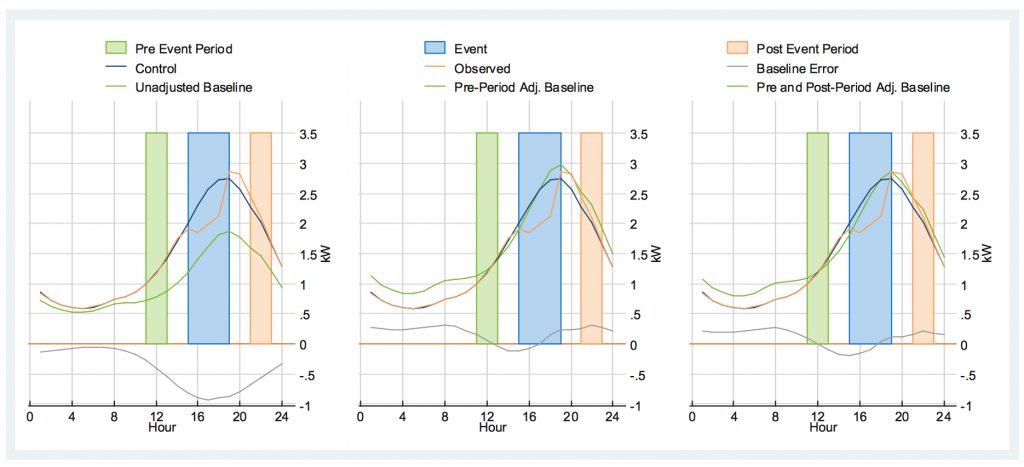
EnergyHub Team
June 23, 2017
The California ISO (CAISO) finalized a proposal June 15 that aims to, among other things, overhaul how residential baselines are determined for demand response events.
In an effort to identify and develop methods that will more accurately estimate the load impact of a wide variety of demand response resources, CAISO commissioned the Baseline Accuracy Working Group (BAWG), which included industry experts from research firms, IOUs, and demand response providers (DRPs), including EnergyHub.
It is widely recognized that the current methodology for estimating baselines for demand response is problematic and creates a barrier to entry for DRPs, and that problem has the potential to get worse over time.
“California knows it needs to incorporate more residential resources into the wholesale market,” said Erika Diamond, EnergyHub’s VP and GM of Energy Markets. “That’s virtually impossible to do without accurate baselines, and CAISO did a great job putting together this group and working with several stakeholders to create a proposal that works for everyone.”

EnergyHub is excited to announce our support of this proposal that will surely go a long way toward improving demand response efforts in California.
Here is a look at why the proposal was developed, and how it will improve the accuracy of demand response baseline estimates.
The need to improve demand response baseline estimates
CAISO currently relies on a 10-in-10 baseline with a 20 percent same-day adjustment to estimate the load impact achieved by a demand response resource. This means that all of the 10 eligible days leading up to the event day are averaged to form the baseline, which is then scaled by up to 20 percent to match the pre-event load curve. While this method can be accurate for medium and large commercial and industrial customers, research has shown it’s not accurate for many others — including residential customers.
The well-known proliferation of grid-edge distributed energy resources (DERs) in California means the ISO has a wide variety of resources whose load impact needs to be accurately estimated during demand response events. Inaccurate baselines can underestimate load reduction, leading to decreased revenue or even penalties for providers.
Enhancing the accuracy and precision of estimated baselines
The BAWG analyzed three classes of baselines to identify the methodologies that most improve upon the 10-in-10. Each uses a different approach to determine what the population load curve would have looked like during the event, absent control:
- Control Groups – Uses the unadjusted consumption of a prespecified control group, consisting of non-dispatched customers with similar profiles
- Day Matching – Selects the most elevated, recent load curves from the dispatched population itself
- Weather Matching – Selects historical load curves from the dispatched population, based on similar cooling degree days (CDD) or greatest peak outdoor temperature
The BAWG found that using randomized control groups of 200-400 customers were more than twice as precise than using the day matching or weather matching techniques. CAISO continues to support these baselines, however, because smaller aggregation sizes can make it prohibitively expensive — or impossible — for a DRP to withhold a control group.
Using pre- and post-event adjusted baselines
In traditional demand response baseline methodologies, the raw day or weather matching baseline is adjusted to match the event day curve based only on pre-event data. This leaves the baseline vulnerable to late-day ramping behavior, an established aspect of California’s well-known “duck curve” phenomenon.
EnergyHub VP of Analytics Ben Hertz-Shargel (also a member of the BAWG), introduced the idea of a post-event adjustment, which allows the methodology to make use of information after the event, including the degree of late-day ramp. This increases accuracy without introducing contamination from the post-event snapback. Statistical analyses performed by Navigant demonstrated improvement from the post-event adjustment in almost all scenarios.
The figure below illustrates that a pre- and post-event adjustment of a matching baseline more closely approximates a control group baseline — the gold standard for accuracy — than a pre-event adjustment alone.
Note in particular, in the middle plot, the gap between the pre-period-adjusted baseline (green) and control group baseline (blue), indicating a significantly overestimated late-day ramp. In the third plot, the gap between the pre- and post-adjusted baseline (also green) and control is smaller. Greater accuracy before and after the event strongly indicate greater accuracy during the event — that is precisely the theoretical assumption behind the adjustment.

Next steps for the proposal and demand response in California
The proposal will be presented at the Energy Imbalance Market Governing Body meeting July 13, and then presented for approval at the CAISO board meeting July 26-27. The proposal has garnered considerable support among stakeholders, including IOUs, and EnergyHub expects it to be approved.
Along with other market reforms EnergyHub has advocated for in California, the new baseline methodologies will lower the barrier to entry of residential load resources in wholesale markets, furthering the state’s transition to a clean energy future.
CAISO’s support of the BAWG
Throughout our time working with the BAWG, EnergyHub was very pleased to work alongside some of the best minds in the energy sector.
We’d like to thank CAISO and the other members of the BAWG who contributed to the proposal for fostering an accommodating, engaging process
You can find a full copy of BAWG’s proposal here.
Note: The BAWG consisted of industry experts from research firms, IOUs, and demand response providers — including EnergyHub’s VP of Analytics Ben Hertz-Shargel, VP and GM of Energy Markets Erika Diamond, and Senior Associate, Market Operations, Laura Kier.
Interested in keeping up with the latest dispatch from the grid edge?
Get our next post in your inbox.


